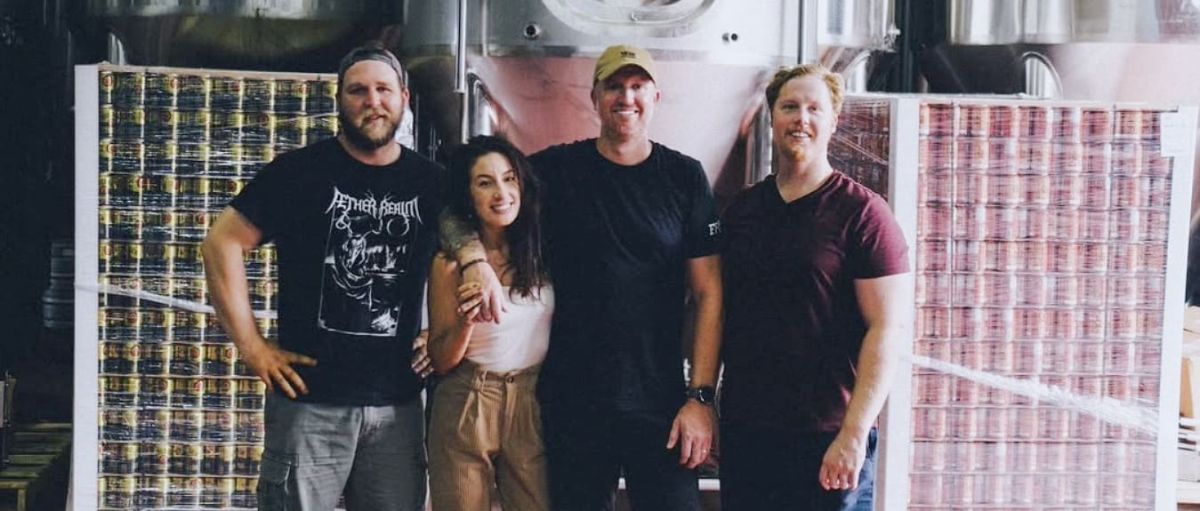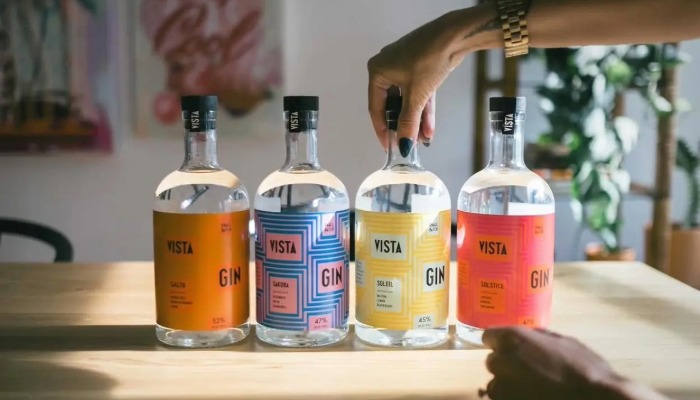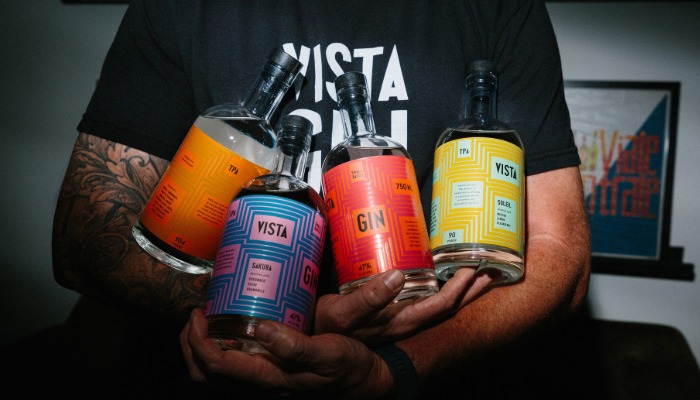Warehouse
Closed
July 10, 2026
Judging
Date
July 26, 2026
Winners
Announced
August 12, 2026

What began as a shared obsession between two friends—a distiller and a dreamer—has since become one of the most intriguing names in modern spirits. Vista Gin, co-founded by CEO Grant Patterson and head distiller Jesse Tate, wasn’t born from a boardroom strategy but from a deep reverence for craft and experimentation. Over six years and countless trial batches, the duo has created a lineup of distinctive gins that challenge expectations with ingredients like matcha, shiso, and smoky Lapsang Souchong tea. Their mission? To show the world that gin doesn’t have to be stiff, staid, or predictable—it can be vibrant, versatile, and endlessly surprising.
Edited excerpts from the interview.
Honestly, when we started, there wasn’t a grand business plan or a clear endgame. It all began with Jesse—he’s a distiller by trade—and his passion for the craft. He was already deep in the industry, experimenting, learning, and refining his approach.
What really drove us was the desire to make something we genuinely loved. Over the past six years, we’ve focused on perfecting that—tweaking, testing, and evolving until we landed on something we felt was truly worth sharing. For us, it was always product first. We weren’t setting out just to start a distillery—we created something we believed in, and that belief naturally evolved into a business. We think that’s the strongest foundation any brand can have.
We never set out to make "unusual" gins for the sake of being different. Our approach has always been flavour-first. Every gin we’ve created started with a clear sense of what we wanted to taste—then it became about exploring how to get there.
Take Sakura, for example. I knew I wanted to work with shiso leaf. You know those little green plastic dividers in supermarket sushi trays? That’s meant to resemble shiso. I eventually tried the real green shiso and thought, this is it—minty, vegetal, aromatic. So I bought two pounds… of the wrong kind. Red shiso. But that mistake turned out to be a breakthrough. When I distilled it, the depth was incredible—earthy, herbal, with notes of anise and tarragon. It was complex, unexpected, and totally captivating.
That’s the kind of happy accident that helped shape our lineup. With Soleil, for instance, we layered ceremonial-grade matcha with gyokuro tea—not just for trendiness, but because each contributes its own nuance to the final profile. It’s about layering, balance, and building a tasting experience that evolves with every sip.
Jesse and I would literally experiment in the kitchen, swapping ideas, tasting sample batches, and fine-tuning until it felt right. We’d say, “I love this note—how do we bring more of that forward?” or “This is missing something—what if we tried this instead?”
We also made a deliberate decision to include a tea ingredient in every gin. Tea brings incredible structure and depth to a botanical blend, and it helped us create distinct profiles for each product. For example, Solstice gets its smoky edge from Lapsang Souchong tea—that tea alone defines much of the gin’s character.
So yes, we’ve pushed boundaries. But only when it made the gin better. We weren’t chasing novelty—we were chasing flavour. That’s what guided every blend. And that’s why each bottle tells its own story, both through the botanicals and the design itself. The labels even show the key ingredients—because we want people to understand exactly what they’re tasting from the moment they pick it up.
Oh, there were plenty of misfires. I still have a spreadsheet with tabs labeled In Development, Completed, and Never Again. That last one is pretty full.
Jesse once gave me a batch that tasted like straight vinegar—I didn’t realize it for a solid five seconds. Not one of our finer moments. He also tried working with Munich malt. He still thinks it has potential, but for me, that flavor is forever cursed.
The truth is, we had to experiment to find the magic. Some flavor combos just don’t belong together, but you don’t know until you distill them and taste what happens. It’s a process of elimination, and sometimes total surprises.
And listen, we’re not expecting everyone to love every gin we make. That’s why we have four very different expressions. If someone tries them all, chances are they’ll love one, like another, and maybe not care for the rest. And that’s okay. You don’t have to like every one of them—you just have to find your gin.

Left to Right: Salto; Sakura; Soleil; Solstice
That’s a great question—and something we think about a lot. What we’ve consistently seen is that our gins don’t just resonate with everyday consumers, they also strike a chord with bartenders, mixologists, and bar program directors who are looking for something specific to match their concept.
Every venue has its own identity, and professionals in this space really get that. A cocktail bar focusing on Asian small plates might gravitate toward Sakura with its shiso and matcha notes. A coastal restaurant might lean into Soleil’s citrus-forward profile. It’s not about pushing all four expressions everywhere—it’s about finding the right match for the bar's culinary or beverage vision.
That’s why we don’t just drop off samples—we leave behind tailored materials, including recipe pamphlets with simple three-ingredient builds as well as more complex, creative cocktails. We want to meet people where they are, whether they’re running a high-volume bar or a tightly curated beverage program.
As for where gin sits in cocktail culture right now? We’re seeing way more gin cocktails pop up on curated menus, especially those focused on craft and storytelling. And our gins aren’t made to sit quietly in the background. They’re bold and botanical, designed to lead the flavor conversation. That’s a big shift from the classic London dry style, where gin often plays a supporting role.
What’s really exciting is how much our products simplify the cocktail creation process. Because the flavor is already layered and expressive, you don’t need ten ingredients to make something interesting. A well-balanced Vista cocktail can be as simple as three thoughtfully chosen components—and that’s something bartenders love. It’s creative, efficient, and guests keep coming back for more.
At the end of the day, we want to give people behind the bar a new tool to work with—one that fits their menu, surprises their guests, and helps tell a fresh story about what gin can be.
We’ve actually built an online experience around this—where people answer lifestyle questions and get matched with the gin that best fits them. Since most buyers don’t get to try all four before purchasing, we’ve put real thought into how each expression aligns with different moods, moments, and types of drinkers.
Each expression aligns with a season, a mindset, and a flavor profile—so whether you're easing into gin or seeking something bold and new, there’s a Vista for you.
Right now, the focus is on growing Vista—getting our core lineup into more hands, more bars, and more markets. But we’re a craft distillery at heart, and we’ve definitely been experimenting behind the scenes. There’s potential for limited releases, maybe a fifth or sixth seasonal expression, and even a few ideas outside the gin category. It’s early days for those, but the long-term vision goes beyond gin. For now, it’s about building a strong foundation and expanding strategically into new regions.

Vista Gin (Facebook)
That gin can be different—and genuinely enjoyable. We didn’t reinvent the category, we just made it worth drinking. Time and again, we’ve had people say, “I don’t like gin,” only to walk away with a bottle of Vista. It’s incredibly rewarding to watch that shift happen. If someone’s willing to be a little adventurous, Vista shows them that gin can be bright, flavorful, and surprisingly versatile. That moment of conversion—that’s what we live for.
Grant Patterson: Salto, hands down. I love it in a Coffee Negroni—just swap the vermouth for a great coffee liqueur like Mr. Black. It's also incredible on its own over ice with a slice of orange.
Jesse Tate: Sakura is my go-to. I'm no expert bartender, but it shines in classic cocktails like the Last Word. The flavor is so well-balanced, it gives me room to experiment—even when I don’t get the recipe exactly right.
Header image sourced from Vista Gin (Instagram).
The 2025 Winners List is Now Live! Explore the Full List!